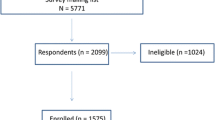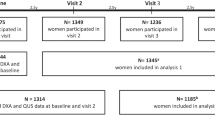Abstract
Summary
This nested case-control analysis of a Swiss ambulatory cohort of elderly women assessed the discriminatory power of urinary markers of bone resorption and heel quantitative ultrasound for non-vertebral fractures. The tests all discriminated between cases and controls, but combining the two strategies yielded no additional relevant information.
Introduction
Data are limited regarding the combination of bone resorption markers and heel quantitative bone ultrasound (QUS) in the detection of women at risk for fracture.
Methods
In a nested case-control analysis, we studied 368 women (mean age 76.2 ± 3.2 years), 195 with low-trauma non-vertebral fractures and 173 without, matched for age, BMI, medical center, and follow-up duration, from a prospective study designed to predict fractures. Urinary total pyridinolines (PYD) and deoxypyridinolines (DPD) were measured by high performance liquid chromatography. All women underwent bone evaluations using Achilles+ and Sahara heel QUS.
Results
Areas under the receiver operating-characteristic curve (AUC) for discriminative models of the fracture group, with 95% confidence intervals, were 0.62 (0.56–0.68) and 0.59 (0.53–0.65) for PYD and DPD, and 0.64 (0.58–0.69) and 0.65 (0.59–0.71) for Achilles+ and Sahara QUS, respectively. The combination of resorption markers and QUS added no significant discriminatory information to either measurement alone with an AUC of 0.66 (0.60–0.71) for Achilles+ with PYD and 0.68 (0.62–0.73) for Sahara with PYD.
Conclusions
Urinary bone resorption markers and QUS are equally discriminatory between non-vertebral fracture patients and controls. However, the combination of bone resorption markers and QUS is not better than either test used alone.

Similar content being viewed by others
References
Cummings SR, Melton LJ (2002) Epidemiology and outcomes of osteoporotic fractures. Lancet 359:1761–1767
Szulc P, Delmas PD (2008) Biochemical markers of bone turnover: potential use in the investigation and management of postmenopausal osteoporosis. Osteoporos Int 19:1683–1704
Garnero P, Delmas PD (2004) Contribution of bone mineral density and bone turnover markers to the estimation of risk of osteoporotic fracture in postmenopausal women. J Musculoskelet & Neuronal Interact 4:50–63
Garnero P, Hausherr E, Chapuy MC et al (1996) Markers of bone resorption predict hip fracture in elderly women: the EPIDOS Prospective Study. J Bone Miner Res 11:1531–1538
Weel AEAM, Seibel MJ, Hofman A et al (1999) Which fractures are associated with high bone resorption in elderly women: the Rotterdam study. J Bone Miner Res 14([Suppl 1]):S160 Abstract 1110
Chapurlat RD, Garnero P, Breart G, Meunier PJ, Delmas PD (2000) Serum type I collagen breakdown product (serum CTX) predicts hip fracture risk in elderly women: the EPIDOS study. Bone 27:283–286
Akesson K, Ljunghall S, Jonsson B et al (1995) Assessment of biochemical markers of bone metabolism in relation to the occurrence of fracture: a retrospective and prospective population–based study of women. J Bone Miner Res 10:1823–1829
Garnero P, Sornay-Rendu E, Claustrat B, Delmas PD (2000) Biochemical markers of bone turnover, endogenous hormones and the risk of fractures in postmenopausal women: the OFELY study. J Bone Miner Res 15:1526–1536
Ivaska KK, Gerdhem P, Akesson K et al (2007) Bone turnover markers and prediction of fracture: nine-year follow-up study of 1040 elderly women. J Bone Miner Res 22([Suppl 1]):S21 Abstract 1073
Melton LJ 3rd, Crowson CS, O’Fallon WM, Wahner HW, Riggs BL (2003) Relative contributions of bone density, bone turnover, and clinical risk factors to long-term fracture prediction. J Bone Miner Res 18:312–318
Garnero P, Dargent-Molina P, Hans D et al (1998) Do markers of bone resorption add to bone mineral density and ultrasonographic heel measurement for the prediction of hip fracture in elderly women? The EPIDOS prospective study. Osteoporos Int 8:563–569
Hans D, Dargent-Molina P, Schott AM et al (1996) Ultrasonographic heel measurements to predict hip fracture in elderly women: the EPIDOS prospective study. Lancet 348:511–514
Bauer DC, Gluer CC, Cauley JA et al (1997) Broadband ultrasound attenuation predicts fractures strongly and independently of densitometry in older women. A prospective study. Study of osteoporotic fractures research group. Arch intern med 157:629–634
Stewart A, Kumar V, Reid DM (2006) Long-term fracture prediction by DXA and QUS: a 10-year prospective study. J Bone Miner Res 21:413–418
Pluijm SM, Graafmans WC, Bouter LM, Lips P (1999) Ultrasound measurements for the prediction of osteoporotic fractures in elderly people. Osteoporos Int 9:550–556
Diez-Perez A, Gonzalez-Macias J, Marin F et al (2007) Prediction of absolute risk of non-spinal fractures using clinical risk factors and heel quantitative ultrasound. Osteoporos Int 18:629–639
Huopio J, Kroger H, Honkanen R, Jurvelin J, Saarikoski S, Alhava E (2004) Calcaneal ultrasound predicts early postmenopausal fractures as well as axial BMD. A prospective study of 422 women. Osteoporos Int 15:190–195
Khaw KT, Reeve J, Luben R et al (2004) Prediction of total and hip fracture risk in men and women by quantitative ultrasound of the calcaneus: EPIC-Norfolk prospective population study. Lancet 363:197–202
Krieg MA, Cornuz J, Ruffieux C et al (2006) Prediction of hip fracture risk by quantitative ultrasound in more than 7000 Swiss women > or =70 years of age: comparison of three technologically different bone ultrasound devices in the SEMOF study. J Bone Miner Res 21:1457–1463
Hans D, Hartl F, Krieg MA (2003) Device-specific weighted T-score for two quantitative ultrasounds: operational propositions for the management of osteoporosis for 65 years and older women in Switzerland. Osteoporos Int 14:251–258
Krieg MA, Cornuz J, Ruffieux C et al (2003) Comparison of three bone ultrasounds for the discrimination of subjects with and without osteoporotic fractures among 7562 elderly women. J Bone Miner Res 18:1261–1266
Cornuz J, Krieg MA, Burckhardt P (1999) Vorstellung der Studie “Schweizerische Evaluierung des Messmethoden des Osteoporotischen Frakturrisikos” (SEMOF). Schweiz Ärzteztg 80:349–352
Kanis JA, Johnell O, Oden A, Johansson H, McCloskey E (2008) FRAX and the assessment of fracture probability in men and women from the UK. Osteoporos Int 19:385–397
Cornuz J, Krieg MA, Sandini L et al (2003) Factors associated with the use of hormone replacement therapy among older women. Age Ageing 32:675–678
Bio-Rad (2002) Pyridinium-Crosslinks by HPLC, nouvelle calibration. Notice d′utilisation
Krieg MA, Barkmann R, Gonnelli S et al (2008) Quantitative ultrasound in the management of osteoporosis: the 2007 ISCD official positions. J Clin Densitom 11:163–187
Njeh CF, Blake GM (1999) Calcaneal quantitative ultrasound: Water-coupled. In: Njeh CF, Hans D, Fuerst T, Glueer C-C, Genant HK (eds) Quantitative ultrasound: assessment of osteoporosis and bone status. Martin Dunitz, London, pp 109–124
Cheng S, Hans D, Genant H (1999) Calcaneal quantitative ultrasound systems: Gel-coupled. In: Njeh CF, Hans D, Fuerst T, Glueer C-C, Genant HK (eds) Quantitative ultrasound: assessment of osteoporosis and bone status. Martin Dunitz, London, pp 125–144
DeLong ER, DeLong DM, Clarke-Pearson DL (1988) Comparing the areas under two or more correlated receiver operating characteristic curves: a nonparametric approach. Biometrics 44:837–845
Robins SP, Woitge H, Hesley R, Ju J, Seyedin S, Seibel MJ (1994) Direct, enzyme-linked immunoassay for urinary deoxypyridinoline as a specific marker for measuring bone resorption. J Bone Miner Res 9:1643–1649
Seyedin SM, Kung VT, Daniloff YN et al (1993) Immunoassay for urinary pyridinoline: the new marker of bone resorption. J Bone Miner Res 8:635–641
Colwell A, Russell RG, Eastell R (1993) Factors affecting the assay of urinary 3-hydroxy pyridinium crosslinks of collagen as markers of bone resorption. Eur J Clin Investig 23:341–349
Seibel MJ (2000) Molecular markers of bone turnover: biochemical, technical and analytical aspects. Osteoporos Int 11 Suppl 6:S18–S29
Gerdhem P, Ivaska KK, Alatalo SL et al (2004) Biochemical markers of bone metabolism and prediction of fracture in elderly women. J Bone Miner Res 19:386–393
Chen JS, Seibel MJ, Zochling J et al (2006) Calcaneal ultrasound but not bone turnover predicts fractures in vitamin D deficient frail elderly at high risk of falls. Calcif Tissue Int 79:37–42
Gluer MG, Minne HW, Gluer CC et al (2005) Prospective identification of postmenopausal osteoporotic women at high vertebral fracture risk by radiography, bone densitometry, quantitative ultrasound, and laboratory findings: results from the PIOS study. J Clin Densitom 8:386–395
Seibel MJ (2005) Biochemical markers of bone turnover: part I: biochemistry and variability. Clin Biochemist 26:97–122
Bettica P, Taylor AK, Talbot J, Moro L, Talamini R, Baylink DJ (1996) Clinical performances of galactosyl hydroxylysine, pyridinoline, and deoxypyridinoline in postmenopausal osteoporosis. J Clin Endocrinol Metab 81:542–546
Del Campo MT, Gonzalez-Casaus ML, Aguado P, Bernad M, Carrera F, Martinez ME (1999) Effects of age, menopause and osteoporosis on free, peptide-bound and total pyridinium crosslink excretion. Osteoporos Int 9:449–454
Heiss C, Hoesel LM, Wehr U et al (2004) Vitamin K in combination with other biochemical markers to diagnose osteoporosis. Biomarkers 9:479–488
Marin F, Gonzalez-Macias J, Diez-Perez A, Palma S, Delgado-Rodriguez M (2006) Relationship between bone quantitative ultrasound and fractures: a meta-analysis. J Bone Miner Res 21:1126–1135
Njeh CF, Hans D, Li J et al (2000) Comparison of six calcaneal quantitative ultrasound devices: precision and hip fracture discrimination. Osteoporos Int 11:1051–1062
Hartl F, Tyndall A, Kraenzlin M et al (2002) Discriminatory ability of quantitative ultrasound parameters and bone mineral density in a population-based sample of postmenopausal women with vertebral fractures: results of the Basel Osteoporosis Study. J Bone Miner Res 17:321–330
McLaren AM, Isdale AH, Whiting PH, Bird HA, Robins SP (1993) Physiological variations in the urinary excretion of pyridinium crosslinks of collagen. Br J Rheumatol 32:307–312
Kanis JA, Borgstrom F, De Laet C et al (2005) Assessment of fracture risk. Osteoporos Int 16:581–589
Acknowledgements
The authors are very grateful to the SEMOF group which authorized us to use their database.
Conflicts of interest
None
Author information
Authors and Affiliations
Consortia
Corresponding author
Rights and permissions
About this article
Cite this article
Nanchen, D., Cornuz, J., Ruffieux, C. et al. Combining bone resorption markers and heel quantitative ultrasound to discriminate between fracture cases and controls. Osteoporos Int 20, 1695–1703 (2009). https://doi.org/10.1007/s00198-009-0843-z
Received:
Accepted:
Published:
Issue Date:
DOI: https://doi.org/10.1007/s00198-009-0843-z




